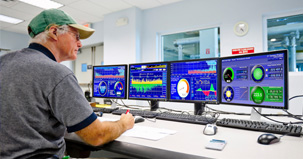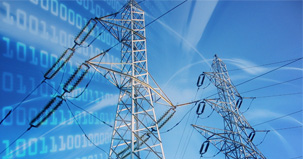- Home
- Smart Data
Smart Data
Actionable intelligence on energy and water use:
- Helps users identify inefficencies, and waste
- Provides real-time feedback on conservation
Right data for the right audience:
- Facility managers identify when and where energy is wasted
- CFO's can track and verify financial savings from initiatives
- Company knows its carbon and water footprint
Related Products
 Information any time, anywhere
Information any time, anywhere - Smart User
Smart User
Smart users leverage real-time data and reduce energy and water use by:
- Continuously identifying opportunities
- Acting on opportunities
- Tracking and verifying savings
- Sustaining savings
Related Products
 Monitor, Manage, Maintain
Monitor, Manage, Maintain - Smart Community
Smart Community
A smart community is one where all stakeholders are engaged in energy and water conservation. A smart community can be achieved by:
- Showing people precisely how much they are using
- Providing real-time feedback on conservation actions
- Effectively communicating efficiency results
Related Products
 Communicate and Conserve
Communicate and Conserve - Smart Grid
Smart Grid
Smart grid, as we define it, is a "green grid", with efficient resource use and the key to a low-carbon future. We help our customers prepare for the smart grid by:
- Engaging users with smart data
- Enabling smart users to increase resource efficiency
- Educating & empowering smart communities
Related Products
 Smart grid and a smarter future
Smart grid and a smarter future - Smart Buildings
Smart Buildings
Smart buildings maximize resource (energy, water, capital) efficiency. These buildings are optimized using energy and water management process with high data visibility which lead to reduced energy and water spending.
- Higher operating income and higher asset values for owners
- Increased productivity for occupants
- Lower carbon footprint for the community
 Resource efficient buildings
Resource efficient buildings
Recent Posts
Noveda's Energy Monitoring System Has Clients Seeing "Green"
Did you know that there are over 4.8 million commercial buildings and another 350,000 industrial facilities in the United States? The combined annual energy costs for these buildings is more than $202 billion!
The most unfortunate part of this equation is the one least understood. More than 30 percent of these buildings operate inefficiently, unnecessarily wasting energy and money. By installing an energy monitoring system in your facility, you can be sure your building’s systems are working at optimum levels. And, if something goes wrong, you will be notified of the problem and able to rectify it immediately – saving energy and money.
Case in point: Liberty Science Center in Jersey City, N.J.
In 2007-08, LSC reports using 10,158,516KWh at a cost of more than $1.5 million! After a complete facility overhaul in 2007, facility managers at the Liberty Science Center (LSC) decided to get serious about lowering energy usage and costs.
LSC contracted with Noveda Technologies (www.noveda.com), an award-winning global leader in real-time, web-based energy system monitoring, to ensure ROI on the energy savings fixtures it put in place. In April 2008, LSC installed the Noveda EnergyFlow Monitor™ and SunFlow Monitor™, to track energy use and to monitor the performance of the facility’s solar photovoltaic system, respectively.
“It turns out that saving energy is a lot like losing weight – facilities often seek a quick fix to lower energy bills by slashing energy usage, but they can’t sustain it. A year later, they find that energy consumption has crept back up again,” LSC’s Director of Facilities, Dennis Hercel, wrote in his LSC blog. (https://lscgreen.wordpress.com/2010/06/30/22/)
“The only way to lose weight and keep it off is to pay close attention to how many calories you consume versus how many you use,” he added. “The only way to permanently reduce energy use is to know in detail how much energy you are using and how it is being used.” After the first night in use, EnergyFlow Monitor™ data showed that the facility was consuming three times more energy than originally estimated. The facility operations staff at LSC discovered, between the hours of 10 p.m. and 6 a.m., their air handling units were running in occupied mode, bringing hot, humid air back into the building and wasting energy. By readjusting the night settings, daily electrical consumption was reduced by approximately 11 percent.
Year over year, the savings is extraordinary! LSC saved more than $700,000. After employing the Noveda energy monitoring systems, the museum reduced electricity consumption in 2008-2009 by 4,210,070 KWh for a savings of $665,193.00 and reduced its natural gas consumption by $50,000.
Having access to the Noveda real-time data enabled LSC staff to track energy use, drive new energy savings initiatives and monitor their impact in real-time. Some of the initiatives include: turning off booster pumps for hot water at night, adjusting lighting hours, cycling major equipment to maximize efficiency and comfort, and upgrading lighting fixtures.
Noveda’s client base includes renewable systems users, utilities, commercial, retail, industrial, government, and educational institutions. “Every building that has a meter is our potential customer,” Noveda CEO Govi Rao explained.
While there are many companies in the marketplace offering monitoring services, Noveda presents clear advantages. The technology is easy to install and to use. It’s compatible with all leading Building Automation Systems (BAS), Energy Management Systems (EMS), and Utility Meters.
But perhaps the most significant value add offered by Noveda’s products is that it is web-based; the customer has access to a large database of real-time energy data whenever they want or need it. With Noveda’s tools, “we’re able to see detailed conditions in real time. That allows us to monitor how much energy an elevator ride costs, how much energy the solar panels produce on a partly cloudy day, and even how much energy we save by turning off lights in little-used staff areas,” Hercel blogged. “We’ve used the tool to closely examine everything in the institution that pulls power, leaving no stone unturned. Nothing is too small to study, understand, adjust, and create savings.”
Originally published in renewablenergyworld.com



